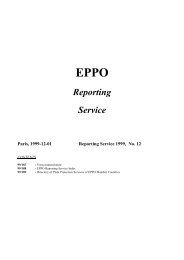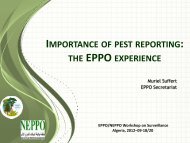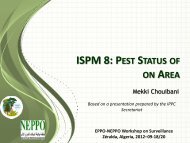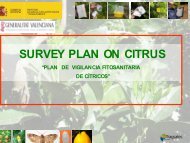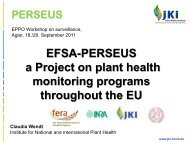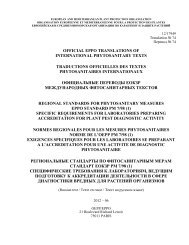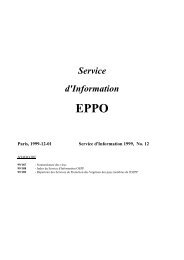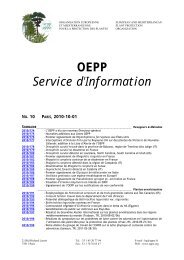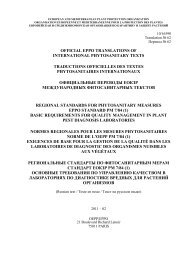EPPO Reporting Service - Lists of EPPO Standards - European and ...
EPPO Reporting Service - Lists of EPPO Standards - European and ...
EPPO Reporting Service - Lists of EPPO Standards - European and ...
You also want an ePaper? Increase the reach of your titles
YUMPU automatically turns print PDFs into web optimized ePapers that Google loves.
<strong>EPPO</strong> <strong>Reporting</strong> <strong>Service</strong> – Pests & Diseases<br />
Pictures can be viewed on the Internet:<br />
http://cemariposa.ucdavis.edu/files/67726.pdf<br />
http://berrygrape.org/files/Dsuzukii_alert.pdf<br />
http://cisr.ucr.edu/spotted_wing_drosophila_cherry_vinegar_fly.html<br />
http://www.agf.gov.bc.ca/cropprot/swd.htm<br />
Reproduction in Drosophila species is particularly rapid with a short life cycle <strong>of</strong><br />
1 to 2 weeks depending <strong>of</strong> the climatic conditions, therefore a single pair <strong>of</strong> flies<br />
can produce hundreds <strong>of</strong> <strong>of</strong>fspring within a couple <strong>of</strong> weeks. In Japan, D. suzukii<br />
has about 13 generations per year, <strong>and</strong> predictions made for the Californian<br />
climate are <strong>of</strong> 3 to 10 generations per year. D. suzukii seems to prefer high<br />
humidity <strong>and</strong> moderate temperatures. Cold winters do not seem to limit the<br />
insect’s survival, considering its establishment in Northern China <strong>and</strong> the<br />
Southern part <strong>of</strong> Hokkaido (Japan).<br />
Dissemination Adults are highly mobile. The rapid spread which is currently being observed in<br />
North America demonstrates the high capacity <strong>of</strong> this insect for natural spread.<br />
Over long distances, trade <strong>of</strong> infested fruit <strong>and</strong> plants can ensure pest<br />
dissemination. For the moment, it is not known how D. suzukii was introduced<br />
into North America <strong>and</strong> Europe.<br />
Pathway Plants <strong>of</strong> planting, fruit <strong>of</strong> D. suzukii host plants.<br />
Possible risks Many host plants <strong>of</strong> D. suzukii (e.g. Fragaria, Prunus, Rubus, Vaccinium, Vitis<br />
vinifera) are economically important crops across the <strong>EPPO</strong> region. The high<br />
reproduction rate <strong>and</strong> capacity for natural spread probably render containment<br />
or eradication very difficult. In addition, early infestations are difficult to detect<br />
(small oviposition scars) <strong>and</strong> these infested fruit are likely to be traded<br />
undetected. For the moment, data is lacking on the potential <strong>of</strong> establishment <strong>of</strong><br />
D. suzukii in the <strong>EPPO</strong> region, but the fact that D. suzukii seems to favour cool<br />
<strong>and</strong> humid climate (e.g. in central coastal California) suggests that it probably<br />
has the potential to establish in most parts <strong>of</strong> the <strong>EPPO</strong> region. Preliminary<br />
results from Climex/Maxent modelling studies (done for North America only)<br />
showed that D. suzukii has the potential to establish along the west coast <strong>of</strong> USA<br />
<strong>and</strong> Canada (e.g. British Columbia), <strong>and</strong> in large parts <strong>of</strong> Eastern USA. For the<br />
moment, data is lacking about field (e.g. ‘attract-<strong>and</strong>-kill strategy’) <strong>and</strong> postharvest<br />
treatments (e.g. cold treatments, fumigation, irradiation) but<br />
investigations are being initiated in the USA. It is considered that sanitation<br />
techniques (fruit removal, pruning) could help to reduce pest populations. There<br />
is no data on biological control but it is mentioned in the Japanese literature<br />
that larvae <strong>of</strong> D. suzukii were naturally parasitized by a species belonging to the<br />
genus Phaenopria (Hymenoptera: Diapriidae). Although data is lacking about the<br />
insect biology <strong>and</strong> its economic impact, preliminary observations made in<br />
countries where the pest has been introduced, suggest that D. suzukii is a serious<br />
threat to many fruit crops in the <strong>EPPO</strong> region.<br />
Source(s) Deng Q, Zeng Q, Qian Y, Li C, Yang Y (2007) Research on the karyotype <strong>and</strong> evolution <strong>of</strong> Drosophila<br />
melanogaster species group. Journal <strong>of</strong> Genetics <strong>and</strong> Genomics 34(3), 196-213.<br />
Gupta JP (1974) The family Drosophilidae in India. Indian Biologist 5, 7-30.<br />
Grassi A, Palmieri L, Giongo L (2009) [Drosophila (Sophophora) suzukii (Matsumura) – New pest <strong>of</strong><br />
small fruit crops in Trentino]. Terra Trentina no. 10, 19-23 (in Italian). Available online:<br />
http://www.ufficiostampa.provincia.tn.it/binary/pat_ufficio_stampa/terra_trentina/PATTN_Not_T<br />
erraTrentina_10.1259743077.pdf<br />
Hauser M, Gaimari S, Damus M (2009) Drosophila suzukii new to North America. Fly Times no. 43, 12-<br />
15. Available online: http://www.nadsdiptera.org/News/FlyTimes/issue43.pdf<br />
Kanzawa T (1936) [Studies on Drosophila suzukii Mats]. Journal <strong>of</strong> Plant Protection (Tokyo) 23(1/3),<br />
66-70 (in Japanese) (abst.).<br />
Kanzawa T (1939) [Studies on Drosophila suzukii Mats]. K<strong>of</strong>u, Yamanashi Agric. Exp. Sta., 49 pp (in<br />
Japanese) (abst.).<br />
Kikkawa H, Peng FT (1938) Drosophila species <strong>of</strong> Japan <strong>and</strong> adjacent localities. Japanese Journal <strong>of</strong><br />
Zoology 7, 507-552.<br />
Momma E (1965) The dynamic aspects <strong>of</strong> Drosophila populations in semi-natural areas. I. Associations<br />
<strong>and</strong> relative numbers <strong>of</strong> species. Part 1. Results <strong>of</strong> trapping. Japanese Journal <strong>of</strong> Genetics 40(4),<br />
275-295.<br />
NPPO <strong>of</strong> Italy (2009-11).<br />
O’Grady PM, Beardsley JW, Perreira WD (2002) New records for introduced Drosophilidae (Diptera) in<br />
Hawai’i. Bishop Museum occasional papers no. 69, 34-35.<br />
6





